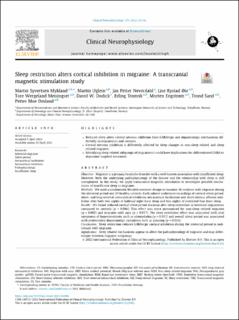| dc.contributor.author | Mykland, Martin Syvertsen | |
| dc.contributor.author | Uglem, Martin | |
| dc.contributor.author | Neverdahl, Jan Petter | |
| dc.contributor.author | Øie, Lise Rystad | |
| dc.contributor.author | Meisingset, Tore Wergeland | |
| dc.contributor.author | Dodick, David W. | |
| dc.contributor.author | Tronvik, Erling Andreas | |
| dc.contributor.author | Engstrøm, Morten | |
| dc.contributor.author | Sand, Trond | |
| dc.contributor.author | Omland, Petter Moe | |
| dc.date.accessioned | 2023-04-13T12:56:05Z | |
| dc.date.available | 2023-04-13T12:56:05Z | |
| dc.date.created | 2022-04-22T10:26:37Z | |
| dc.date.issued | 2022 | |
| dc.identifier.citation | Clinical Neurophysiology. 2022, 139 28-42. | en_US |
| dc.identifier.issn | 1388-2457 | |
| dc.identifier.uri | https://hdl.handle.net/11250/3062923 | |
| dc.description.abstract | Objective Migraine is a primary headache disorder with a well-known association with insufficient sleep. However, both the underlying pathophysiology of the disease and the relationship with sleep is still unexplained. In this study, we apply transcranial magnetic stimulation to investigate possible mechanisms of insufficient sleep in migraine. Methods We used a randomised, blinded crossover design to examine 46 subjects with migraine during the interictal period and 29 healthy controls. Each subject underwent recordings of cortical silent period, short- and long-interval intracortical inhibition, intracortical facilitation and short-latency afferent inhibition after both two nights of habitual eight-hour sleep and two nights of restricted four-hour sleep. Results We found reduced cortical silent period duration after sleep restriction in interictal migraineurs compared to controls (p = 0.046). This effect was more pronounced for non-sleep related migraine (p = 0.002) and migraine with aura (p = 0.017). The sleep restriction effect was associated with ictal symptoms of hypersensitivity such as photophobia (p = 0.017) and overall silent period was associated with premonitory dopaminergic symptoms such as yawning (p = 0.034). Conclusions Sleep restriction reduces GABAergic cortical inhibition during the interictal period in individuals with migraine. Significance Sleep related mechanisms appear to affect the pathophysiology of migraine and may differentiate between migraine subgroups. | en_US |
| dc.language.iso | eng | en_US |
| dc.publisher | Elsevier | en_US |
| dc.rights | Navngivelse 4.0 Internasjonal | * |
| dc.rights.uri | http://creativecommons.org/licenses/by/4.0/deed.no | * |
| dc.title | Sleep restriction alters cortical inhibition in migraine: A transcranial magnetic stimulation study | en_US |
| dc.title.alternative | Sleep restriction alters cortical inhibition in migraine: A transcranial magnetic stimulation study | en_US |
| dc.type | Peer reviewed | en_US |
| dc.type | Journal article | en_US |
| dc.description.version | publishedVersion | en_US |
| dc.source.pagenumber | 28-42 | en_US |
| dc.source.volume | 139 | en_US |
| dc.source.journal | Clinical Neurophysiology | en_US |
| dc.identifier.doi | 10.1016/j.clinph.2022.04.004 | |
| dc.identifier.cristin | 2018342 | |
| dc.relation.project | Norges forskningsråd: 328615 | en_US |
| cristin.ispublished | true | |
| cristin.fulltext | original | |
| cristin.qualitycode | 2 | |

